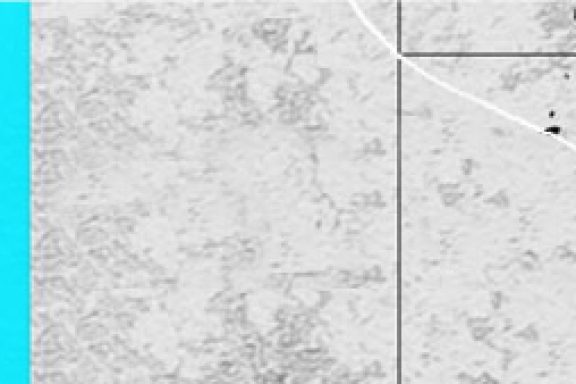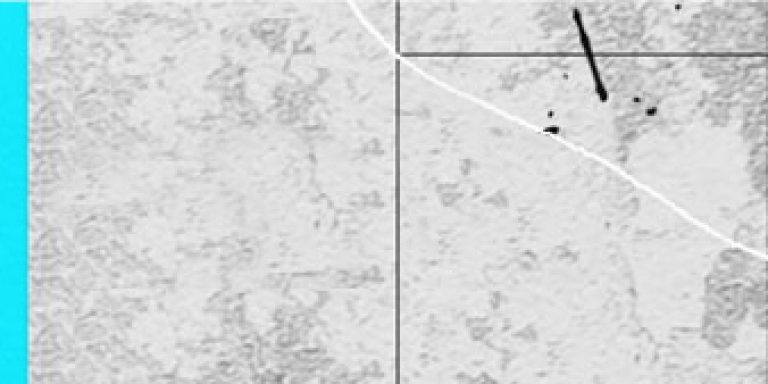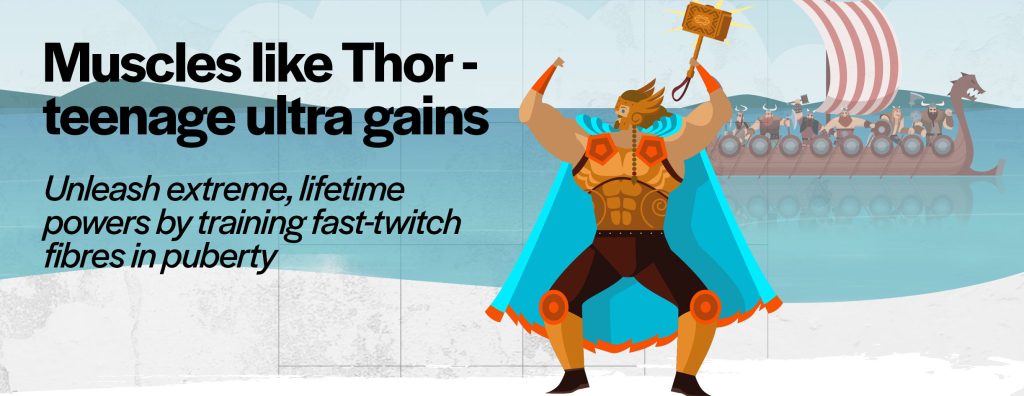You have a puberty superpower to develop muscle tone for life and you need to grab it now. Between the ages of 10 to 17 you have literally a once-in a lifetime opportunity to turn your type 1 slow twitch muscles into type 2 fast twitch muscles.
Toned muscles are the classic representation of athletes – in fact they make up about 50% of everyone’s bodyweight. If you are an athlete, this percentage is even bigger. I’ll explain why you can switch it up during puberty – you can increase your strength five-fold in those few years. But first – an anatomy lesson.
The anatomy of a muscle
For strength, you are probably thinking about skeletal muscles which enable our joints to perform the most amazing activities.
Both skeletal muscles (and the involuntary ones which you don’t think about so much) are a bundle of bundles of bundles. Seriously: one muscle is divided into many fascicles, which in turn are composed of muscle fibres*.
Each individual fibre is only capable of producing a tiny bit of force, but wait until a larger group is activated simultaneously! You need fine control or you would either be slumped or jumping as high as you can the moment after, no in-betweens. This fine-tuning is the methodical sectorialisation of the muscle. Each bunch of fibres is innervated and controlled by the brain separately through a motor nerve, deciding how many fibres are activated according to the effort estimated* .
How do muscles develop from birth?
A newborn can’t even hold their head up – unimpressive. Six months in and brain, nerves and main muscles (legs, arms and some core) grow to allow some gross motor skills – crawling and turning your head – not exactly a cheetah cub. More strength and accuracy are gained at a steady pace until puberty is hit**.
So far, there just wasn’t enough hormones to back up any significant growth that was not already “mapped” in your normal development. In puberty this changes radically: there are literally so many hormones circulating in your body that any form of constructive exercise can potentially transform you – strength can increase up to five-fold!**. Plus, the difference in testosterone and oestrogen sanctions the final differentiation between boys and girls, with a great advantage in terms of muscle mass for the former.
Upgrading your low-twitch muscles
Not all muscle fibres are created equal: type I (slow-twitch) don’t produce high speed or strength, but they can sustain a moderate effort for a long time. Those are packed with capillaries and burn mainly oxygen coming from the lungs through the bloodstream, a slow but reliable source of energy. Think about walking, jogging or even standing.
Type II fibres (fast-twitch) are responsible for the furthest throw, the highest jump, the heaviest lift you can imagine***. They are specialised in using the ready-to-go stores of phosphocreatine (PC), a quick injection of supercharged fuel stored directly within the muscle. Unfortunately, after between 10 and 120 seconds this energy is depleted and you need a few minutes, sometimes even hours, to recover****.
As a general rule, the whole body average is roughly a 50-50 split between these two muscle types. But different muscle groups in different parts of the body have a different mix. Let’s say you go for a walk in the woods that end up being about 3-4 hours long. Your calves, quadriceps, hamstrings have worked for 4 consecutive hours! Not to mention the muscles in your back which keep you upright for the whole day. In these areas type I fibres are predominant. Now try this: grab one water bottle each hand and extend your arms. Keep them there for as long as you can. I bet your shoulders start burning after one minute! In our arms, we have a strong predominance of type II fibres.
Sport-specific adaptations will make your brain/nervous system better at using one of the two types, after years and years of training. The fibres you need will be repeatedly activated by the motor nerves and will become bigger, stronger and more efficient*****.
The puberty superpower
Now here’s your chance! Our bodies are almost incapable of transforming type I fibres into type II, while it is a lot easier the other way around. It is very natural for us to be good at small prolonged efforts, and a lot more challenging to sprint or do heavy lifting******.
It’s different for teens! Due to the unique mix of hormones and growth spurts, after the age of 10 until about age 17 type I muscles can actually become type II muscles. It is still a hard process, but a lot easier than after you turn 20. Even if you might not need powerful movement at the moment******* – you might love long distance running or table tennis – remember that this is too great a chance to miss. Play the long game!
References
*Ackland, R. T., Elliott, C. B., Bloomfield, J. (2009) Applied anatomy and biomechanics in sport. Champaign: Human Kinetics.
**Lloyd, S. R, Oliver, L. J. (2014) Strength and Conditioning for young athletes: science and applications. London: Routledge.
***Karp, J. R. (2001) ‘Muscle fibre types and training’. Strength and Conditioning Journal, 23(5), 21-26.
****Cormie, P., McGuigan, M. R., Newton, R. U. (2011) ‘Developing Maximal Neuromuscular Power – Part 2. Sports Med.’ 41(2) 125-146.
*****Franchi, M.V., Longo, S., Mallinson, J., Quinlan, J. I., Taylor, T., Greenhaff, P. L., Narici, M. V. (2017) ‘Muscle thickness correlates to muscle cross sectional area of strength training induced hypertrophy.’ Scandinavian Journal of Medical Sport Science, 28, 846-853.
******Grgic, J., Mcllvenna, L., C., Fyfe, J. J., Sabol, F., Bishop, D. J., Schoenfeld, B., J., Pedisic, Z. (2018) ‘Does Aerobic training promote the same skeletal muscle hypertrophy as resistance training? A systematic review and meta-analysis’ Journal of sports medicine, 49, 233-254.
*******Gervasi, M., Calavalle, A. R., Amatori, S., Grassi, E., Benelli, P., Sestili, P., Sisti, D. (2018) ‘Post-activation potentiation increases recruitment of fast twitch fibers: a potential practical application in runners.’ Journal of Human Kinetics 65, 69-78.





